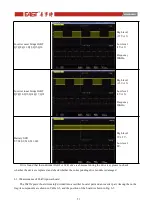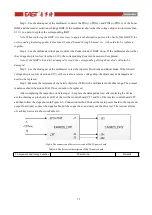
56
Fig.6-7 Key components identification of 30kVA power board
The detailed maintenance steps are as follows:
Step 1: Check whether the copper foil is corroded and rusted on the whole power board. You can use a
multimeter to assist in the inspection. If there is corrosion, the copper foil needs to be re-soldered.
Step 2: Visually inspect the entire power board for obvious burns or cracks, and replace if necessary.
Step 3: Use the diode gear of the multimeter to detect the PIN1(+)-PIN3(-) and PIN2(+)-PIN3(-) of the boost
IGBT and the inverter outer/inner bridge IGBT. If the multimeter shows that the voltage drop is too low (less than
0.1V), you need to replace the corresponding IGBT.
Note: When replacing the IGBT, it is necessary to apply heat dissipation paste on the back of the IGBT. If the
corresponding insulating gasket is blackened, burned, burned through, burned, etc., it should also be replaced
together.
Step 4: Use the multimeter diode gear to detect the Zenner diode of IGBT driver. If the multimeter shows that
the voltage drop is too low (less than 0.1V), the corresponding Zener diode needs to be replaced.
Note: If the IGBT is found to be damaged in step 3, the corresponding driving Zener diode will also be
damaged.
Step 5: Use the diode gear of the multimeter to test the input rectifier diode and Boost diode. If the forward
voltage drop is too low (less than 0.1V) or there is also a reverse voltage drop, the diode may be damaged and
needs to be replaced.
Step 6: Measure the resistance of the battery thyristor (SCR) with a multimeter in the ohm range. The normal
resistance should be around 20Ω. If not, it needs to be replaced.
















































